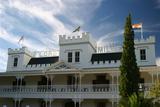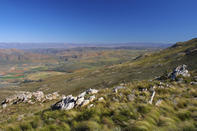A Living Museum
Quite why this scattering of restored Victorian establishments along a dusty railway siding should be the stuff of legend is not at first clear but it is true that there is nothing quite like Matjiesfontein in the whole Karoo.

Matjiesfontein was developed around a railway halt in the Karoo by a Scotsman, Jimmy Logan, and is now a popular South African holiday town.
In the early days of rail travel in South Africa, trains did not have dining carriages, and in 1844 Logan obtained the concession to open a refreshment room at Matjiesfontein. Within a few years, Logan's village had become a popular health and holiday resort, as well as the headquarters of his business enterprises.
The names associated with the country's first health resort read like a Who's Who of nineteenth century South Africa. Olive Schreiner, one of South Africa's earliest femininst writers, Cecil John Rhodes, the diamond magnate and imperialist, Lord Randolph Churchill, father of the more famous Winston, to name but a few of its illustrious patrons.
First for Electricity
The man responsible for this little slice of Scotland on the lonely road through South Africa's parched interior, was one James Douglas Logan, a Scottish adventurer who was shipwrecked on the Cape Peninsula. Starting off as a penniless porter, he subsequently became one of the wealthiest men of the period.
An astute businessman and visionary, his house at Tweedside farm was the first private dwelling in the country to have electricity. And it is Logan we have to thank for water-borne sewage; his was the first flushing loo. He opened his Waterworld resort in November 1889, in one of the driest parts of the country.
Popular lore has it that when congratulated on 'creating a paradise in the desert', Logan replied, 'It is not that I have done so much but that others have done so little.'
War Time Changes

During the South African War, 10 000 British troops and 20 000 horses were quartered in a military camp established on the outskirts of the village. Matjiesfontein's famous hotel, with its towers and ornate cast ironwork, was built during the early stages of the war. The hotel served as a military hospital, while the central turret became a lookout post.
Among the many other fine Victorian buildings lining the main street are the Masonic Hotel, now the Losieshuis, Post Office, Village Office and the Laird's Arms, a Victorian country pub. After Logan's death in 1920, the village sank into obscurity, and declined even further when the new national road, built at the end of World War II, bypassed the village.
Ups and Downs
While Matjiesfontein Village has met with both rising and falling prosperity over the last century, today it has been resurrected anew as a popular stopping-off point on the long road north. In 1968, the entire village was bought by the well-known hotelier David Rawdon, and after careful restoration, the Lord Milner Hotel was reopened two years later.
If you're inclined to get into the spirit of the thing, the period Lord Milner Hotel insists on dressing for dinner while Logan's Masonic Hotel is now the boarding house and doesn't have a dress code.
The Laird's Arms provides wood-panelled shade amidst cricket memorabilia for thirsty travellers and there's the Marie Rawdon Museum, which contains a fine collection of Victorian and Edwardian domestic articles and furniture, as well as a collection of costumes and dresses. Plus there is Olive Schreiner's rented cottage for the insatiably curious. And of course, the inevitable church.